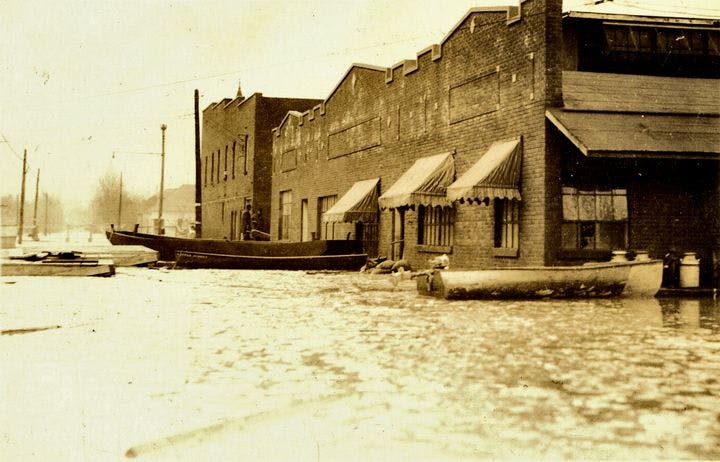Fall 2011
Water Over the Bridge
– Edward Tenner
“The Thousand-Year Flood” masterfully brings a turning point in American history back to life.
Almost 75 years ago, the city fathers of Portsmouth, Ohio, ordered the sewers opened so that high water from the Ohio River would inundate the town gradually rather than violently. As a journalist of the time commented, “The people knew better than to argue with the river.” Triggered by days of torrential rainstorms that astounded even many veterans of earlier floods, the waters in January 1937 would eventually crest 15 feet above flood stage and earn the engineering designation of “thousand- year flood,” one statistically expected to occur once in a millennium.
Farming tracts and urban neighborhoods long classified as safe havens were inundated. Railroad and highway traffic was interrupted and power stations stopped working as waters spread where planners had never imagined they could. (In this respect, the Ohio-Mississippi Flood of 1937 resembles the tsunami in Japan earlier this year as much as it does the aftermath of Hurricane Katrina in 2005.) All told, financial losses were estimated at a billion dollars (roughly $15 billion today). A million people fled their homes. Hundreds died, mostly from pneumonia and other flood-related illnesses.
Yet today few remember the 1937 flood, though it was more severe than the famous Mississippi River flood of a decade earlier, remarks David Welky, an associate professor of history at the University of Central Arkansas. National media, which were concentrated in the Northeast, Chicago, and California, gave the flood short shrift. But, as Welky suggests, the crisis has also been forgotten because the Flood Control Act of 1938 changed the perception of the Ohio (and other rivers) from “disaster waiting to happen” to “pleasant view.”
The flood has three interwoven stories. One is geographic. Land hunger had encouraged the construction of homes and businesses in areas known to be flood prone. The relatively steep slopes of the Ohio River make it potentially more volatile than the Mississippi —which, for all its power, overflows gradually during heavy rains. The physical conformation of the Ohio valley inhibits control of the river by dams, but also increases its scenic allure, drawing people to settle on its treacherous banks. Even after railroads and highways reduced the need for commercial ports on rivers, river towns concentrated essential facilities in known danger zones.
The second narrative is technical. In the 19th century, two influential civil engineers offered rival visions for managing the Ohio. The self-taught Charles Ellet advocated building reservoirs that would intercept floodwaters from the rivers feeding the Ohio while providing drinking water and power for industry. Ellet’s nemesis, the workaholic Andrew Atkinson Humphreys of the U.S. Army Corps of Engineers, published an exhaustive treatise in 1861 on the Mississippi and its management that attacked Ellet’s views on reservoirs in favor of levees located on riverbanks. Through his influence in staffing the corps as much as through his theories, Humphreys established a de facto national pro-levee policy that endured into the 20th century.
The most important story is political. President Franklin Roosevelt, influenced by theorists such as George Soule, saw the flood as an opportunity to establish a powerful, centralized expert body, based on the scientific regional planning embodied in the Tennessee Valley Authority (established in 1933), to manage the valleys of the Ohio, the Mississippi, and other rivers. He didn’t get his wish, but the Flood Control Act did create recreational and wildlife areas and hydroelectric power stations that helped to transform the Ohio valley, making the river for the first time “a friend, an ally, a boon, rather than an enemy.”
These efforts, however, also revealed the New Deal’s limits. Communities in the region were often highly stratified, divided into elite whites, “white trash,” and African Americans, and many—even forward-thinking cities such as Louisville, Kentucky—maintained these divisions when they rebuilt.
We are left with a paradox of memory. A highly successful response to disaster created a solution so lasting that the public has forgotten its origins. For 75 years, the measures introduced by the Flood Control Act of 1938—which called for the construction of flood walls to protect cities in flood zones, the installation of pumping stations, and the creation of scores of manmade lakes that largely vindicated Ellet’s emphasis on flood control reservoirs—have brought security to river communities, though Welky warns that new development on floodplains and overreliance on levees may yet spell disaster in extreme conditions. Vividly written and carefully documented, The Thousand-Year Flood masterfully brings a turning point in American history back to life.
* * *
Edward Tenner, a contributing editor of The Wilson Quarterly, is the author of Why Things Bite Back: Technology and the Revenge of Unintended Consequences (1996) and Our Own Devices: How Technology Remakes Humanity (2003). He is currently at work on a book about positive unintended consequences.
Reviewed: The Thousand-Year Flood: The Ohio-Mississippi Disaster of 1937 by David Welky, University of Chicago Press, 2011, 355 pp.
Photo courtesy of Flickr/Victoria Pickering
